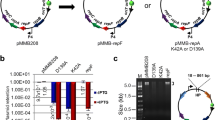Summary
IS2 has been marked genetically by the in vitro insertion into its HindIII site of a 3.3 Kb HindIII fragment of Tn5 conferring resistance to kanamycin. The transposition of the IS2::Km, thus obtained, to λ has been found and insertion sites were characterised. Each of ten independent IS2::Km insertions were found at the same site at 61.2% of the λ map, always in the same orientation (orientation II relative to the xis gene). The integration sites of IS2::Km in five of the kanamycin-transducing phages were determined by DNA sequence analysis, and were found to be identical at the nucleotide level. Further transposition of IS2::Km from λ to the bacterial chromosome was demonstrated.
Similar content being viewed by others
References
Berg DE, Davies J, Allet B, Rochaix J-D (1975) Transposition of R factor genes to bacteriophage λ. Proc Natl Acad Sci USA 72:3628
Bolivar F, Rodriguez RL, Betlach MC, Boyer HW (1977) Construction and characterization of new cloning vehicles. I. Ampicillin resistant derivates of the plasmid pMB9. Gene 2:75
Brachet P, Eisen H, Rambach A (1970) Mutations of coliphage λ affecting the expression of replicative functions O and P. Mol Gen Genet 108:266
Calos MP, Miller JH (1980) Transposable elements. Cell 20:579–595
Clewell DB (1972) Nature of Col E1 plasmid replication in Escherichia-coli in the presence of chloramphenicol. J Bacteriol 110:667
Clewell DB, Helinski DR (1969) Supercoiled circular DNA-protein complex in E. coli: purification and induced conversion to an open circular DNA form. Proc Natl Acad Sci USA 61:1159
Fiethen L, Starlinger P (1970) Mutations in the galactose operator. Mol Gen Genet 108:322
Galas D, Calos MP, Miller J (1980) Sequence Analysis of Tn9 Insertions in the lacZ Gene. J Mol Biol 144:19
Ghosal D, Sommer H, Saedler H (1979) Nucleotide sequence of the transposable element IS2. Nucl Acids Res 6:1111
Grindley NDF (1978) IS1 insertion generates duplication of nine base sequence at its target site. Cell 13:1257
Grunstein M, Hogness DS (1975) Colony hybridization: A method for the isolation of cloned DNAs that contain a specific gene. Proc Natl Acad Sci USA 72:3961
Hoess RH, Foeller C, Bidwell K, Landy A (1980) Site-specific recombination of bacteriophage λ: DNA sequence of regulatory regions and overlapping structural genes for Int and Xis. Proc Natl. Acad Sci USA 77:2482
Jorgensen RA, Rothstein StJ, Reznikoff WS (1979) A restriction enzyme cleavage map of Tn5 and location of a region encoding neomycin resistance. Mol Gen Genet 177:65
Klaer R, Kühn S, Fritz HJ, Tillmann E, Saint-Girons I, Habermann P, Pfeifer D, Starlinger P (1981) Studies on Transposition Mechanism and Specificity of IS4. Cold Spring Harobr Symp Quant Biol 45 (in press)
Kühn S, Fritz H-J, Starlinger P (1979) Close vicinity of IS1 integration sites in the leader sequence of the gal operon of E. coli. Mol Gen Genet 167:235
Mandel M, Higa A (1970) Calcium-dependent bacteriophage DNA infection. J Mol Biol 53:159
Maxam A, Gilbert W (1977) A new method for sequencing DNA. Proc Natl Acad Sci USA 74:560
Meyer J, Iida S, Arber W (1980) Does the Insertion Element IS1 Transpose Preferentially Into A+T-Rich DNA Segments? Mol Gen Genet 178:471
Miller JH (1972) Experiments in molecular genetics. Cold Spring Harbor Laboratory, New York
Murray K, Murray NE (1975) Phage λ receptor chromosomes for DNA fragments made with restriction endonuclease III of Haemophilus influenzae and restriction endonuclease I of Escherichia coli. J Mol Biol 98:551
Musso RE, Rosenberg M (1977) Nucleotide sequences at two sites for IS2 DNA insertion. In: Bukhari AI, Shapiro JA, Adhya SL (eds) DNA insertion elements plasmids and episomes. Cold Spring Harbor Laboratory, New York, p 597
Reif HJ, Arber W (1981) Analysis of Transposition of IS1-kan and its Relatives. Cold Spring Harbor Symp Quant Biol 45:(in press)
Rigby PWJ, Dieckmann M, Rhodes C, Berg P (1977) Labelling desoxyribonucleic acid to high specific activity in vitro by nick translation with DNA polymerase I. J Mol Biol 113:237
Robinson LH, Landy A (1977) HindIII, and HpaI restriction fragment maps of bacteriophage λ DNA. Gene 2:1
Saedler H, Cornelis G, Cullum J, Schumacher B, Sommer H (1981) IS1-mediated DNA Rearrangements. Cold Spring Harbor Symp Quant Biol 45:(in press)
Saedler H, Gullon A, Fiethen L, Starlinger P (1968) Negative Control of the Galactose Operon in E. coli. Mol Gen Genet 102:79
Saedler H, Starlinger P (1967) 0o-mutations in the galactose operon in E. coli. I. Genetic characterization. Mol Gen Genet 100:178
Sanger F, Air GM, Barrel BG, Brown NL, Coulson AR, Fiddes JS, Hutchinson III CA, Slocombe PM, Smith M (1977) Nucleotide sequence of bacteriophage ψX174 DNA. Nature 265:687
Shapiro JA, Adhya SL (1969) The galactose operon of E. coli K-12.II. A deletion analysis of operon structure and polarity. Genetics 62:249
Starlinger P (1980) IS elements and transposons. Plasmid 3:241
Sutcliffe JG (1979) Complete nucleotide sequence of the Escherichia coli plasmid pBR322. Col Spring Harbor Symp Quant Biol XLIII:77
Szybalski EH, Szybalski W (1979) Comprehensive molecular map of bacteriophage λ. Gene 7:217
Tu C, Cohen SN (1980) Translocation specificity of the Tn3 element: characterization of sites of multiple insertions. Cell 19:151
Waltz A, Ratzkin B, Carbon J (1978) Control of experession of a cloned yeast (Saccharomyces cerevisiae) gene (trp5) by a bacterial insertion element (IS2). Proc Natl Acad Sci USA 75:6172
Zissler J, Mosharrafa E, Pilacinski W, Fiandt M, Szybalski W (1977) Position effects of insertion sequences IS2 near the genes for prophage λ insertion and excision. In: Bukhari AI, Shapiro JA, Adhya SL (eds) DNA insertion elements, plasmids, and episomes. Cold Spring Harbor Laboratory, New York, p 381
Author information
Authors and Affiliations
Additional information
Communicated by E. Bautz
Rights and permissions
About this article
Cite this article
Saint-Girons, I., Fritz, H.J., Shaw, C. et al. Integration specificity of an artificial kanamycin transposon constructed by the in vitro insertion of an internal Tn5 fragment into IS2 . Molec. Gen. Genet. 183, 45–50 (1981). https://doi.org/10.1007/BF00270136
Received:
Issue Date:
DOI: https://doi.org/10.1007/BF00270136



